From The Professor's Desk
The Professor’s Desk Opens Again
Before we proceed, a gentle invitation from The Literary Professor: if you haven’t yet explored Part 1 of this journey through the Old English Period, do pause and begin there. In that opening chapter, we walked together through the linguistic and poetic landscape of early English literature — discovering the resilience of Beowulf, the contemplative voices of The Wanderer and The Seafarer, the spiritual vision of Dream of the Rood, and the valour of The Battle of Maldon.
Now, here at The Professor’s Desk, ABS The Literary Professor welcomes you to the next chapter of this exploration. In Part 2, we will turn to the profound contributions of religious poetry, historical scholarship, and royal leadership. Through the voices of Cædmon and Cynewulf, the monumental Ecclesiastical History of Bede, and the visionary efforts of King Alfred the Great, we will continue to trace the legacy of a period that shaped not only the English language, but the very foundations of its literary tradition.
So let us open the scrolls once more — and read forward.
Additional Works and Contributions
Caedmon and Cynewulf
Both Caedmon and Cynewulf are significant figures in Old English literature, known for their contributions to the poetry of the early medieval period.
Caedmon:
Caedmon is one of the earliest known English poets and is often referred to as the “Father of Old English Poetry.” He was an Anglo-Saxon herdsman and layman who lived in the early 7th century at the Abbey of Whitby in Northumbria. According to the Venerable Bede’s “Ecclesiastical History of the English People,” Caedmon was divinely inspired to compose religious poetry even though he had no previous poetic training.
Caedmon’s most famous work is a hymn or song known as “Caedmon’s Hymn.” The hymn is a short piece that praises God as the creator of all things. While Caedmon’s hymn is one of the earliest surviving examples of Old English poetry, not much else is known about his life or works. His significance lies in his role in popularizing the composition of religious poetry in the Old English language.
“Caedmon’s Hymn” is one of the earliest known pieces of Old English poetry and is often considered the oldest surviving example of English literature. It is a short hymn or song that praises God as the creator of all things. The hymn is named after Caedmon, an Anglo-Saxon herdsman and layman who, according to the Venerable Bede’s
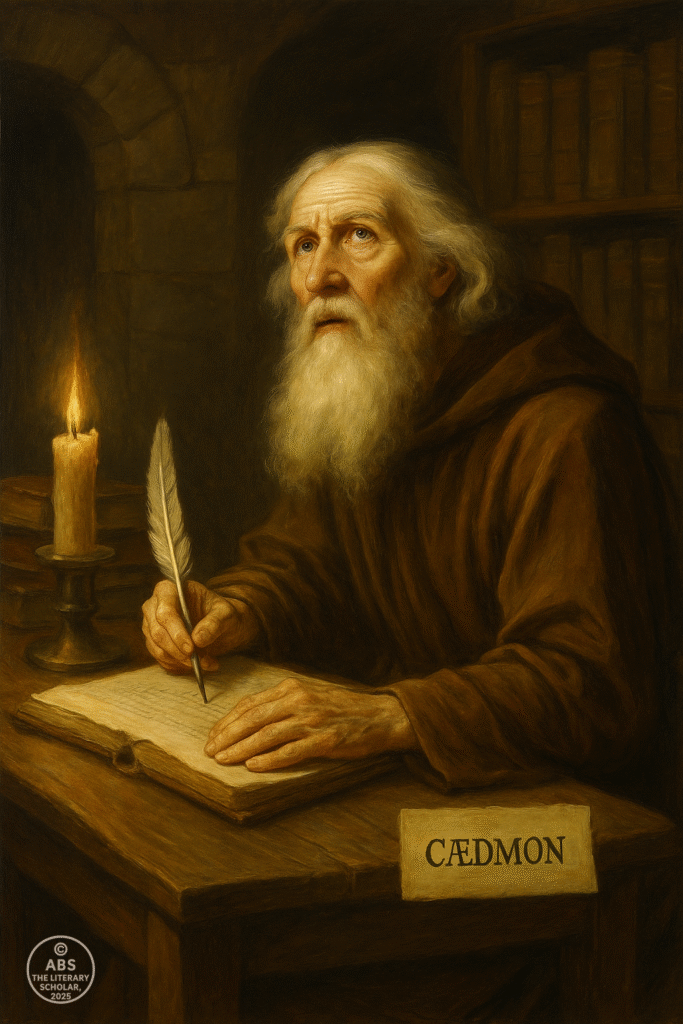
“Ecclesiastical History of the English People,” was divinely inspired to compose religious poetry.
Here is the text of “Caedmon’s Hymn” in its original Old English form followed by a modern English translation:
Original Old English:
Nu sculon herigean heofonrices Weard,
Meotodes meahte and his modgeþanc,
weorc Wuldor-Fæder; swa he wundra gehwæs,
ece Drihten, or onstealde.
Modern English Translation:
Now we must praise the guardian of heaven’s kingdom,
The might of the architect, and his purpose,
The work of the father of glory, as he, the eternal lord,
Established the beginning of wonders.
Key Points about “Caedmon’s Hymn”:
Divine Inspiration: According to Bede’s account, Caedmon was initially unable to compose poetry but was granted the gift of poetic inspiration in a dream. He was instructed to sing about the creation of the world, and upon awakening, he found that he was able to compose verses praising God’s creation.
Praise of Creation: “Caedmon’s Hymn” is a hymn of praise that acknowledges God as the creator of the universe. It celebrates the majesty and power of God and acknowledges his role in bringing about all things.
Creation Narrative: The hymn briefly alludes to the creation narrative found in the Book of Genesis in the Bible. It references the “heofonrices Weard” (guardian of heaven’s kingdom), which echoes the idea of God as the ruler of the heavens.
Use of Alliteration: “Caedmon’s Hymn” is written in Old English alliterative verse, a common poetic form in Anglo-Saxon poetry. Alliteration involves the repetition of initial consonant sounds in stressed syllables.
Early Written Record: “Caedmon’s Hymn” survives in several Old English manuscripts, including the Vercelli Book and the Exeter Book. These manuscripts date back to the late 10th and early 11th centuries.
“Caedmon’s Hymn” is a significant work not only for its historical and literary importance but also for its representation of the religious and cultural values of the early Anglo-Saxon period. It reflects the deep piety and reverence for God’s creation that characterized the worldview of the time.
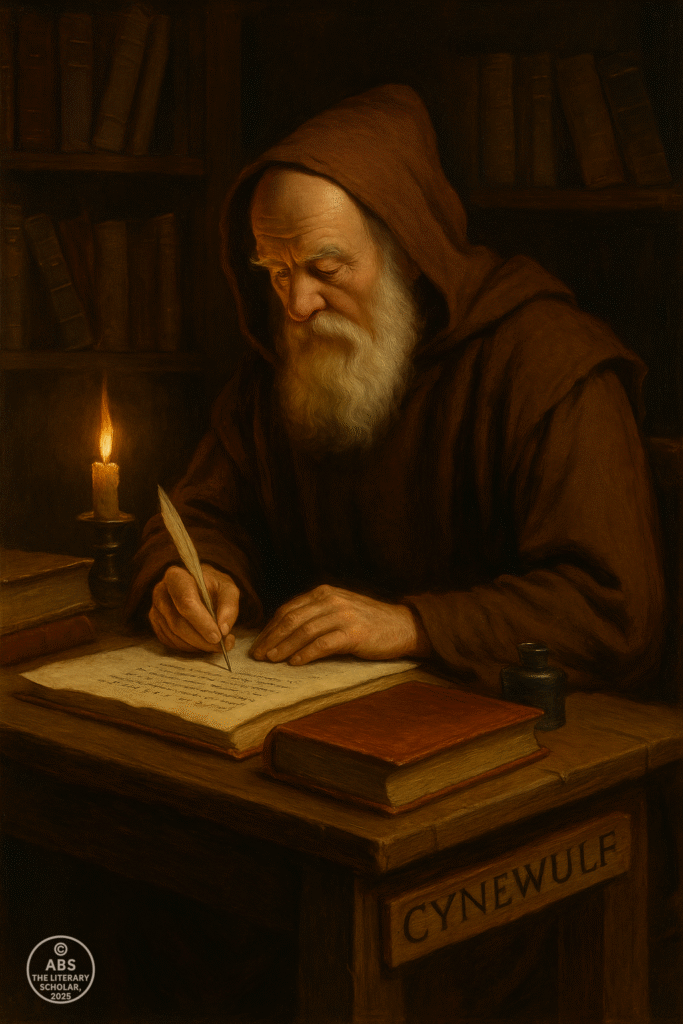
Cynewulf
Cynewulf is another Old English poet, and he is notable for his contributions to a group of poems known as the “Cynewulfian poems.” Like Caedmon, Cynewulf’s exact dates and biographical details are unknown.
The “Cynewulfian poems” include:
“Christ”: This poem is an account of the life, crucifixion, and resurrection of Jesus Christ. It is one of the most significant religious poems in Old English literature.
“Elene”: This poem tells the story of the discovery of the True Cross by the Empress Helena, mother of the Roman Emperor Constantine the Great.
“The Fates of the Apostles”: This poem recounts the martyrdoms of several apostles.
Cynewulf is unique in that he left his name encoded in runic letters within some of his poems. This practice, known as runic signature, allows scholars to attribute certain poems to him.
Both Caedmon and Cynewulf contributed to the development of religious poetry in Old English and played important roles in the literary and cultural landscape of early medieval England. Their works provide insights into the spiritual and intellectual concerns of the time and contribute to the broader understanding of the Old English period.
“Christ” is an Old English poem that is part of a group of poems known as the “Cynewulfian poems,” attributed to the poet Cynewulf. The poem “Christ” is one of the most significant religious poems in Old English literature and focuses on the life, crucifixion, and resurrection of Jesus Christ.
Aspects of “Christ” (Attributed to Cynewulf):
Structure and Content: The poem “Christ” is composed of multiple sections or “cantos,” each dealing with different aspects of the life of Christ. It covers a range of biblical events, from the Annunciation to the Resurrection and Ascension.
Biblical Narrative: The poem closely follows the Gospel accounts of Christ’s life, integrating scriptural passages and narratives into the poetic text. It retells important moments, such as the Nativity, the Sermon on the Mount, the Crucifixion, and the Resurrection.
Spiritual and Didactic Purpose: Like many Old English religious poems, “Christ” serves a didactic purpose. It aims to instruct and edify its audience by conveying the central teachings of Christianity and emphasizing the significance of Christ’s sacrifice for humanity’s salvation.
Lyric and Narrative Elements: “Christ” blends lyrical and narrative elements, featuring both lyrical passages of praise and reflection, as well as narrative descriptions of events. The poem exhibits a skillful use of poetic language and imagery.
Elegiac Tone: The poem’s tone varies throughout its sections. Some parts are joyful and celebratory, while others take on an elegiac and contemplative mood, particularly during Christ’s Crucifixion and Resurrection.
Theological Themes: “Christ” explores theological themes, including the mystery of the Incarnation, Christ’s dual nature as both human and divine, and the significance of Christ’s redemptive sacrifice.
Runic Signature: Like other “Cynewulfian poems,” “Christ” contains a runic signature, where the letters of Cynewulf’s name are encoded in runic characters within the text. This practice suggests that the poet wanted to leave his mark on the work.
Spiritual Journey: The poem can be seen as a spiritual journey, guiding the reader through the life of Christ and inviting reflection on the significance of Christ’s actions and teachings.
The attribution of “Christ” to Cynewulf is based on the runic signature found in the poem. This practice of signing one’s name using runes was a unique feature of Cynewulf’s poetry, allowing scholars to associate certain works with his authorship.
“Christ” is a rich and complex work that provides insights into the religious beliefs, artistic expressions, and linguistic sophistication of the Anglo-Saxon period. It demonstrates the synthesis of Christian themes and poetic artistry that characterizes much of the Old English poetic tradition.
“Elene,” also known as “The Finding of the True Cross,” is an Old English poem that is part of the group of poems attributed to the poet Cynewulf, known as the “Cynewulfian poems.” The poem tells the story of the Empress Helena’s discovery of the True Cross, which is believed to be the cross upon which Jesus Christ was crucified.
“Elene” (Attributed to Cynewulf):
Empress Helena: The poem centers around the historical figure of Empress Helena, the mother of the Roman Emperor Constantine the Great. According to tradition, Helena embarked on a journey to the Holy Land to find the True Cross, which was believed to be the cross upon which Christ was crucified.
Religious Pilgrimage: “Elene” depicts Helena’s journey to the Holy Land as a religious pilgrimage driven by her faith and determination to uncover the holy relic. The poem explores themes of devotion, piety, and the quest for spiritual truth.
Narrative and Themes: The poem narrates Helena’s efforts to locate the True Cross, her interactions with various individuals along the way, and the eventual discovery of the cross. The poem also includes elements of Christian miracle and divine intervention.
Miracles and Conversion: “Elene” includes accounts of miracles performed by God in response to Helena’s prayers. These miracles serve to confirm the authenticity of the True Cross and lead to the conversion of pagans to Christianity.
Lyrical and Reflective Elements: Similar to other “Cynewulfian poems,” “Elene” combines lyrical passages of praise and reflection with narrative storytelling. The poem presents both historical events and moments of spiritual contemplation.
Christian Message: Through the story of Helena’s journey and the discovery of the True Cross, the poem reinforces Christian teachings, highlighting the importance of faith, the power of God’s intervention, and the triumph of Christianity.
Runic Signature: Like other poems attributed to Cynewulf, “Elene” features a runic signature, where the poet’s name is encoded in runic letters within the text.
Literary and Religious Significance: “Elene” is historically significant as it reflects the veneration of relics and the importance of religious pilgrimage in medieval Christianity. It also contributes to the broader themes of the “Cynewulfian poems,” such as the intersection of the sacred and the secular.
“Elene” is a valuable example of Old English religious poetry that combines historical narrative with spiritual themes. It showcases the complex interplay between faith, history, and storytelling in the literary traditions of the Anglo-Saxon period.”The Fates of the Apostles” is one of the Old English poems attributed to the poet Cynewulf, known as a member of the group of poems called the “Cynewulfian poems.” This poem, like others in the group, focuses on religious themes and narratives, specifically recounting the fates and martyrdoms of the apostles of Jesus Christ.
Key Aspects of “The Fates of the Apostles” (Attributed to Cynewulf):
Apostolic Martyrdoms: The poem narrates the individual fates of the apostles who spread the teachings of Jesus Christ after his Ascension. It focuses on the various challenges, trials, and ultimately, the martyrdoms they faced in their efforts to bring Christianity to the world.
Didactic and Inspirational: “The Fates of the Apostles” serves as a didactic work that instructs its audience about the hardships and sacrifices endured by the apostles for their faith. The poem also serves as an inspirational narrative, emphasizing the apostles’ steadfast devotion and commitment to their mission.
Narrative Structure: The poem adopts a structure in which each apostle’s story is presented individually, describing their journeys, encounters, and ultimate fates. This allows for a detailed exploration of their experiences.
Variety of Martyrdoms: The poem portrays a range of martyrdoms, highlighting the different ways in which the apostles met their ends. Some were crucified, others were beheaded, and still others faced other forms of persecution and death.
Runic Signature: Like other poems attributed to Cynewulf, “The Fates of the Apostles” features a runic signature, where the poet’s name is encoded in runic letters within the text.
Spiritual and Historical Significance: The poem provides insight into the early Christian church’s understanding of the apostolic period and the trials faced by those who spread the message of Christianity. It also reflects the broader themes of faith, devotion, and the importance of martyrdom within the context of the Anglo-Saxon religious worldview.
Lyrical and Narrative Elements: Similar to other Cynewulfian poems, “The Fates of the Apostles” blends lyrical passages of praise and reflection with narrative storytelling. The poem’s structure allows for both individual character sketches and collective reflection on the apostles’ sacrifices.
“The Fates of the Apostles” contributes to the body of Old English religious poetry, offering a detailed exploration of the lives and sacrifices of the apostles who played a crucial role in the spread of Christianity. The poem’s emphasis on the apostles’ unwavering commitment to their faith aligns with the broader themes of devotion and spirituality present in the Cynewulfian poems.
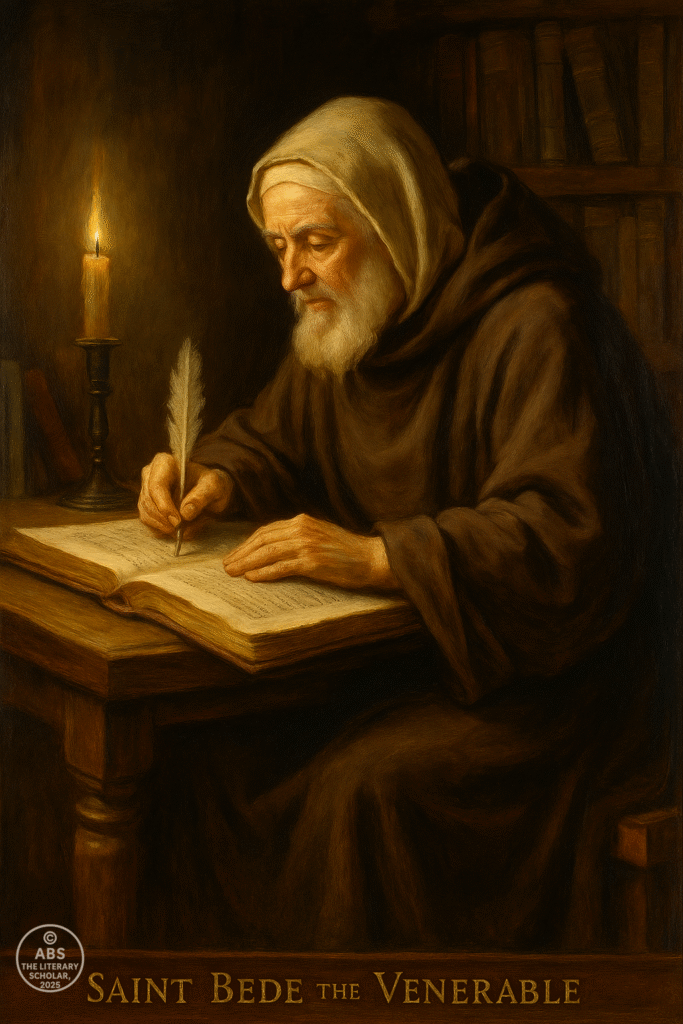
King Alfred the Great (849–899)
King Alfred the Great (849–899) was a notable figure in English history and a significant figure in the development of English culture, literature, and governance during the Anglo-Saxon period. He ruled as the King of Wessex from 871 to 899 and is often remembered for his leadership in defending England against Viking invasions, as well as for his promotion of education and learning.
Key Aspects of King Alfred’s Life and Achievements:
Viking Defense: One of King Alfred’s most significant accomplishments was his successful defense of England against Viking invasions. He faced numerous Viking raids and military campaigns, and he is known for his military strategies and for building fortified defenses to protect his kingdom.
Educational Reforms: King Alfred recognized the importance of education and sought to promote learning among his subjects. He initiated a series of educational reforms, including the translation of important Latin texts into English. He believed that English-speaking people should have access to knowledge in their own language.
Translation Movement: King Alfred is credited with translating or commissioning the translation of several important works from Latin into Old English. He believed that translating these texts would improve the knowledge and understanding of his people. Notably, he sponsored translations of historical, philosophical, and religious texts.
Anglo-Saxon Chronicle: King Alfred played a role in the creation of the Anglo-Saxon Chronicle, a collection of annals that documented historical events in England. The chronicle, which continued to be updated by subsequent generations, provides valuable insights into Anglo-Saxon history.
Law Code: King Alfred is associated with the codification and revision of English laws. He adapted the existing legal codes to better suit the needs of his kingdom and established a system of justice based on fairness and equity.
Religious Devotion: King Alfred was a devout Christian and supported the spread of Christianity throughout his kingdom. He believed in the importance of moral governance and the integration of Christian values into political rule.
Legacy: King Alfred is often referred to as “Alfred the Great” due to his significant contributions to English culture, language, education, and governance. His efforts to strengthen the kingdom, promote learning, and protect English identity during a tumultuous time left a lasting impact on England’s history.
King Alfred’s reign marked a period of cultural and intellectual revival, and his efforts to preserve the English language, literature, and history laid the groundwork for the development of English national identity. His legacy continues to be celebrated for his contributions to both English history and literature.
The Anglo-Saxon Chronicle is a collection of annals that provides a chronological history of England from the early 9th century to the 12th century. It is one of the most important and comprehensive historical sources for understanding the events of the Anglo-Saxon period. While the Chronicle was not authored by a single individual, King Alfred the Great played a role in its creation and continuation.
Key Aspects of the Anglo-Saxon Chronicle in Relation to King Alfred:
Commissioning and Compilation: The Anglo-Saxon Chronicle was likely initiated during the reign of King Alfred. It is believed that he saw the value of recording historical events in writing and initiated the compilation of annals that documented important events of his time.
Educational and Literary Efforts: King Alfred was a strong proponent of education and literacy among his subjects. He recognized that maintaining historical records and sharing knowledge was important for the cultural and intellectual development of his people. The Chronicle served as a way to disseminate knowledge and history.
Translation and Continuation: King Alfred is often credited with translating or adapting certain portions of the Chronicle. He also likely oversaw the continuation of entries beyond his own reign. While some entries may have been composed or translated by Alfred himself, it’s important to note that the Chronicle was a collaborative effort compiled over several generations.
Local and National Histories: The Chronicle contains entries from various Anglo-Saxon kingdoms and regions, reflecting a blend of local and national perspectives. It covers a wide range of topics, including political events, battles, reigns of monarchs, ecclesiastical matters, natural disasters, and more.
Historical Importance: The Anglo-Saxon Chronicle is invaluable for historians and scholars studying the early medieval history of England. It provides insights into the political, social, religious, and cultural dynamics of the Anglo-Saxon period.
Manuscript Copies: Over time, multiple versions or manuscripts of the Chronicle were produced, with each version containing variations and additions. Some versions were associated with specific monastic centers, indicating that these centers played a role in maintaining and updating the Chronicle.
Legacy: The Anglo-Saxon Chronicle continued to be updated and expanded by subsequent generations after King Alfred’s time. It provides a unique window into the development of the English language and historical consciousness.
While the exact extent of King Alfred’s direct involvement in the Chronicle’s creation and continuation is debated among scholars, his efforts to promote education, preserve historical records, and support the dissemination of knowledge contributed to the Chronicle’s compilation and its enduring significance as a primary source for understanding the Anglo-Saxon period.
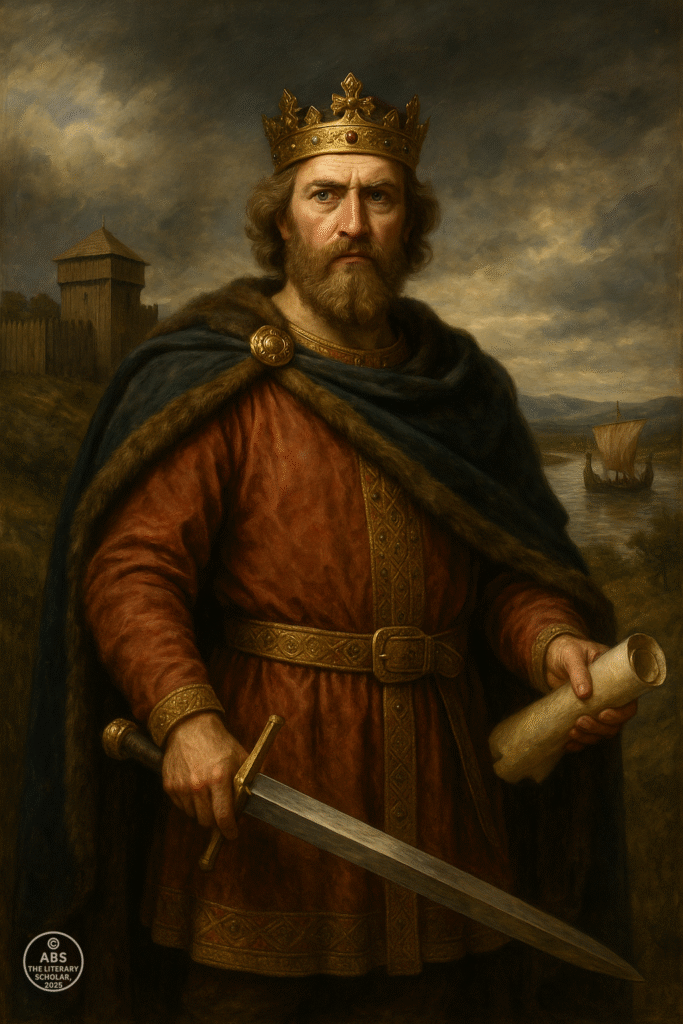
The Foundations of English Literary Legacy
As we close this second part of our journey through the Old English period, it becomes clear that literature in this era was more than epic poetry and heroic battle cries. It was also a profound act of cultural preservation and spiritual expression. The hymns of Cædmon and the poetic voice of Cynewulf extended the reach of sacred verse; the pages of Bede’s Ecclesiastical History transformed historical record into narrative art; the tireless efforts of King Alfred the Great safeguarded knowledge for future generations.
Together, these figures remind us that the roots of English literature lie not only in the grandeur of heroes, but in the quiet labour of scholars, poets, and visionaries. They gave us language, form, and an evolving sense of literary purpose — one that still resonates through the centuries.
Here, at The Professor’s Desk, we honour these voices not as relics of the past, but as enduring contributors to the great unfolding story of English letters. For in every modern poem, novel, or drama, echoes of this distant period remain — subtle reminders of literature’s long and winding path.
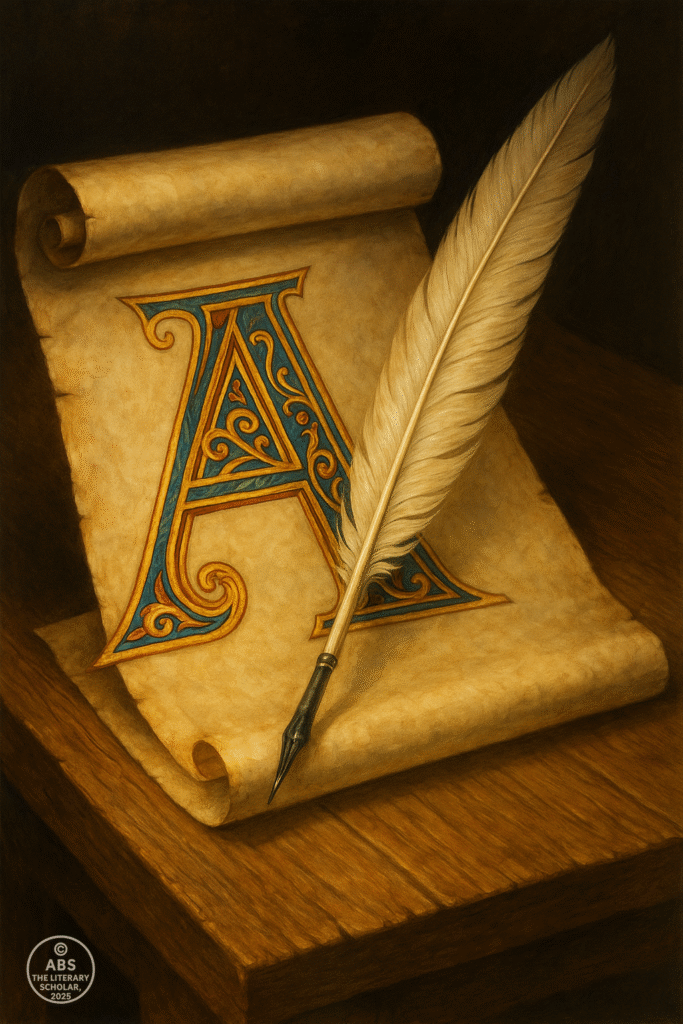
The noblest gift of the old scribes was not their words alone — but the wisdom to keep them alive. And as readers, we inherit that sacred trust.
Signed,
ABS, The Literary Professor
Share this post / Spread the witty word / Let the echo wander / Bookmark the brilliance
